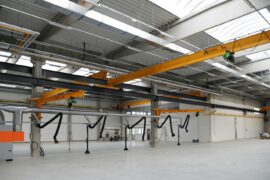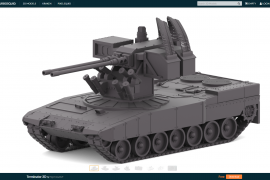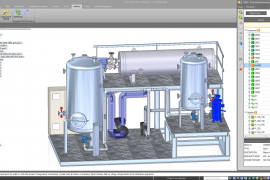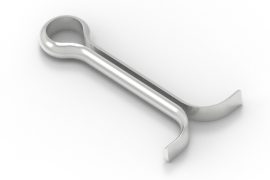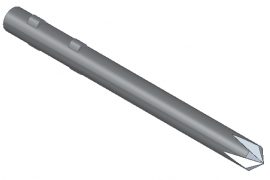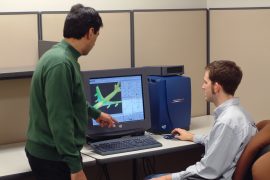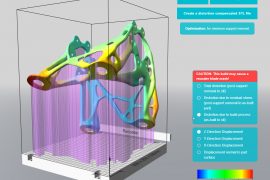Zákazníci společnosti Dassault Systèmes, kterých je v současnosti již více než sto tisíc po celém světě, se dočkali uvedení nové verze PLM řešení s označením V5R21, které zahrnuje zapracované aktuální požadavky uživatelů a zároveň poskytuje lepší spolupráci mezi řešením V5 a V6.
V5R21 se chlubí oboustrannou kompatibilitou dat ze systémů Catia V5 a Catia V6, která je ekvivalentní běžné kompatibilitě dat v rámci dílčích verzí edice V5. Zachovány navíc zůstávají vazby v návrzích mezi daty v systému Catia V5 a V6. Díky využití totožného geometrického jádra v obou verzích programů je možné pracovat v hybridním prostředí, které je určitě efektivnější, než dosavadní spolupráce mezi jednotlivými verzemi.
Z dalších novinek stojí v krátkosti za zmínku vylepšení v oblasti analýz kompozitů nástrojem Simulia Extended Analysis, zdokonalené modelovací vlastnosti systému Catia V5 (tzv. Lofting), v oblasti spolupráce potom rychlejší navigace v technických datech díky nástrojům převzatým ze systému Enovia 3Dlive V6 nebo přímý export plně konfigurovaných návrhových dat ze systému Catia V5 přímo do softwaru 3Dvia Composer V6.
(Zdroj: Tisková zpráva)
Dassault Releases v5R21
VÉLIZY-VILLACOUBLAY, France, July 5, 2011 – Dassault Systèmes (Euronext Paris: #13065, DSY.PA), a world leader in 3D and Product Lifecycle Management (PLM) solutions, announced today the availability of Version 5 Release 21 (V5R21). V5R21 demonstrates Dassault Systèmes’ continued commitment to its popular PLM portfolio, currently deployed in over 100,000 customers worldwide. V5R21 solutions establish “digital continuity” from engineering to real shop floor manufacturing operations to support customer needs, while leveraging Version 6 technologies for better co-existence of V5 and V6 solutions in customer environments.
In V5R21, Dassault Systèmes delivers upward and downward compatibility between CATIA V5 and V6 data that is equivalent to the compatibility between two releases of V5. In addition, V5R21 supports collaborative relational design between CATIA V5 and Version 6, enabling best in class collaboration between OEMs and their supply chain. The original decision to maintain the same geometry kernel between V5 and V6 also makes hybrid design environments much more efficient than previous version-to-version collaboration.
“Even customers who have yet to fully experience our open Version 6 portfolio are gaining the benefits of Dassault Systèmes’ Version 6 developments. Our evolution towards PLM 2 wasn’t just a visionary reimagining of what PLM could do for our customers,” explained Dominique Florack, senior executive vice president, Products, Research and Development, Dassault Systèmes. “What we are seeing in V5R21 are the combined fruits of our Version 6 and Version 5 developments.”
V5R21 includes new composites analysis enhancements to SIMULIA Extended Analysis, new CATIA Lofting capabilities, improvements to ENOVIA SmarTeam Express’ out-of-the-box offering for the Industrial Equipment and Energy industries, improvements to ENOVIA’s concurrent engineering functionality, as well as many other capabilities, and the integration of Version 5-compliant Intercim MES capabilities.
The recent acquisition of Intercim and its MES and quality improvement solutions continues to expand Dassault Systèmes’ manufacturing reach by defining a new step for PLM that delivers open digital continuity from engineering to real factory operations for highly regulated industries. V5R21’s new open Shop Order product enables DELMIA to be tightly integrated with either Dassault Systèmes or third-party MES solutions.
V5R21: Continued Enrichment
V5R21 Virtual Design Enhancements:
- CATIA Imagine & Shape, the virtual clay modeler based on subdivision surface technology, addresses the high standards Dassault Systèmes automotive customers require in body shape design. It delivers three types of Imagine & Shape improvements: enhanced body shape detailing, (e.g. cutting face, N-gone, etc), enhanced user experience with in-context manipulation, and real-time rendering visual feedback during product design. In yet another example of Dassault Systèmes’ solution openness, V5R21 now provides a way to import “subdivision surfaces” coming from third-party software through standard .obj files.
- V5 Class A Surfacing now matches CATIA V6’s advanced and powerful freeform surface modeling, modification and analysis capabilities. This completes the feature set alignment between the 2 versions, started in V5R19.
- New machining processes and simulation capabilities in pocketing enhance quality, reduce machining time and enables faster programming. V5R21 delivers a new process for hard material machining to increase tool life duration, and major improvements to multi-pocket flank contouring, such as feed rate reduction in corner and control overlap for close tool paths.
- CATIA Wire Harness’ productivity and usability is improved with a new 3D label selection process during flattening. Synchronization of components is simpler and more robust with superior branch management and efficient hybrid parts components handling.
- CATIA V5’s Lofting solution has been enhanced to define continuity in curvature (G2 – with section supports or guide supports) where previously only tangent continuity was supported.
V5R21 Realistic Simulation Enrichments:
- Import composites data direct from CATIA Composites Design – SIMULIA Extended Analysis allows V5 users to perform nonlinear and thermal stress analysis within the CATIA V5 environment, leveraging robust Abaqus FEA technology. With this release it is now possible to import composite properties from the CATIA Composite Design (CPD) workbench into an analysis model, greatly expanding the composite structural analysis capabilities of CATIA integrated analysis. V5R21 also provides a simpler, more efficient approach to contact modeling, using the Abaqus “general contact” technology.
- CATIA Generative Part Structure Analysis – CATIA V5 Analysis provides users with realistic design simulation capability within the CATIA V5 environment. This integrated analysis solution includes linear static stress analysis, transient and harmonic dynamic analysis, contact analysis, buckling analysis and assembly of multiple analysis models. The V5R21 release further enhances the ease of use of CATIA Generative Part Structural Analysis (GPS) by providing a surface selection capability that enables users to select faces by continuity angle. For models with complex surfaces, this enhancement can save substantial time during model creation and make surface selection more reliable and intuitive.
V5R21 Digital Manufacturing and Production Improvements:
- DELMIA announces the new DELMIA Operations domain to optimize real shop floor processes and product quality.
- The new DELMIA Shop Order Release 1 product enables the release of a configured shop order package containing configured production system data and the associated work instructions, for direct use by DELMIA Operations or third-party MES solutions, or simply for viewing on the shop floor. SO1 provides open digital continuity from engineering to real shop floor operations.
- The new DELMIA Process Context Builder 1 delivers DELMIA Work Instruction Composer users the capability to quickly get the context for a specific work instruction in the most desirable 3D view, based on the state of the product assembly at that specific stage or based on surrounding parts/resources via a bounding-box definition.
- Two DELMIA solutions, DELMIA Operations Execution and DELMIA Emergent Process Management now provide managers with additional interactive reports to determine the state of production in their area of responsibility, for decision making support. With OEX, managers are now able to determine open critical tasks that prevent a product from moving to the next phase of the manufacturing process. Additionally with EGP, managers can now generate a report by work center that highlights active unplanned events (e.g. machine breakdown) and the temporary processes defined to resolve them (Emergent Process Documents).
V5R21 Collaborative Innovation:
- The award-winning ENOVIA 3DLive visualization and navigation product now allows much faster navigation of VPM V5 data using the same innovative 3D thumbnails technology originally pioneered in ENOVIA V6. Recognized in 2007 by Design News magazine with a “Better Mousetrap Best Product Award,” this frequently imitated 3D product navigation paradigm allows anybody to search and explore product IP, has been the focus of constant R&D improvements, and is the basis for the entire V6 platform’s user interface experience.
- In yet another effort to enable easy co-existence between V5 and V6 solutions, ENOVIA V5R21 can now export fully configured CATIA V5 design data, including customer-defined attributes, directly into 3DVIA Composer V6 – the premier solution for 3D interactive technical communications.
- ENOVIA Virtual Product Model (VPM) technology, which powers unmatched relational design and concurrent engineering capabilities, is further improved with a more refined data lock mechanism, all the way down to the graphical attribute management level. This allows multiple users to work on the same assembly, especially to reuse and move design components, while other users can continue their work on other parts.
- ENOVIA VPM V5 now includes the ability to 3D Preview a product or part on demand, without opening a user’s CAD/authoring solution. This is another example of a V6 technology transfer into V5.
- In this release, ENOVIA has refined its out-of-the-box ENOVIA SmarTeam Express offering to capture best practices from its core products and further reduce its implementation cycle. Special attention was given in V5R21 to comprehensive solutions for the Industrial Equipment and Energy industries.
A complete list of functionality enhancements in V5R21 is available athttp://www.3ds.com/products/v5-latest-release/.
About Dassault Systèmes
As a world leader in 3D and Product Lifecycle Management (PLM) solutions, Dassault Systèmes brings value to more than 130,000 customers in 80 countries. A pioneer in the 3D software market since 1981, Dassault Systèmes applications provide a 3D vision of the entire lifecycle of products from conception to maintenance to recycling. The Dassault Systèmes portfolio consists of CATIA for designing the virtual product – SolidWorks for 3D mechanical design – DELMIA for virtual production – SIMULIA for virtual testing – ENOVIA for global collaborative lifecycle management, EXALEAD for search-based applications and 3DVIA for online 3D lifelike experiences. For more information, visithttp://www.3ds.com.

